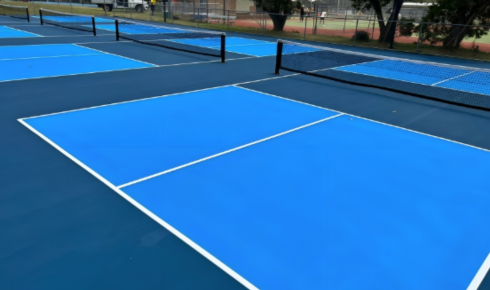Pickleball—a unique mix of tennis, badminton, and ping-pong—is becoming one of the fastest-growing sports in the world. Whether for private backyards, residential societies, schools, clubs, or commercial recreation centers, the demand for well-constructed pickleball court flooring is increasing rapidly.
But one crucial question always arises during planning: which materials should you use to build a high-performance, durable pickleball court? The answer can directly impact the playing experience, longevity of the surface, and even safety of the players.
Let’s break it down step by step and help you make the right choice when building your pickleball court.
Why Choosing the Right Material Matters
A pickleball court isn’t just a flat surface with painted lines—it’s a carefully engineered space designed for optimum speed, bounce, and safety. The materials you choose will determine:
- How the ball bounces
- How much grip players have while moving
- Whether the surface can withstand weather changes
- How much maintenance is needed over time
Without the right pickleball court material, even a well-designed court can become a source of constant repairs, injuries, and frustration.
Foundation: Start With the Base
Before considering the top surface, you need a strong foundation. The most commonly used base materials for pickleball courts are:
1. Concrete
Concrete is the most recommended base for outdoor courts. It’s strong, durable, and long-lasting. It provides a stable and even platform for applying surface coatings and helps in reducing surface cracks.
2. Asphalt
Asphalt is also used in some courts, especially where budget constraints exist. However, it is more flexible and may develop cracks over time, especially in extreme weather. Concrete still remains the first choice for durability.
Top Surface: The Game-Changer in Pickleball Court
Once your base is ready, the real game begins—the top surface coating. This is what players interact with, and it directly affects performance. The three main options are:
1. Synthetic Acrylic Surface (Recommended)
Synthetic acrylic pickleball flooring is the preferred surface material for most professional and amateur pickleball courts. It’s a multi-layer system applied over the concrete base and offers the following advantages:
- Consistent Ball Bounce: Synthetic acrylic coatings ensure predictable bounce throughout the court.
- Player Safety: The textured finish provides excellent grip and slip resistance, reducing the risk of falls.
- Weather Resistance: UV-resistant and water-resistant, acrylic can withstand heat, rain, and humidity with minimal damage.
- Custom Appearance: You can choose from a wide range of court colors, ensuring visual appeal along with functionality.
- Low Maintenance: Unlike tiles or turf, acrylic courts only require basic cleaning and occasional resurfacing.
Acrylic systems can also be customized to adjust the pace of the game—fast, medium, or slow—by varying the number of layers and sand texture.
2. Modular Interlocking Tiles (Not Recommended for Permanent Installations)
Some quick-install courts use modular plastic tiles. These are easy to assemble and useful for temporary setups or multipurpose areas. However:
- They can trap dirt and require frequent cleaning.
- They lack the consistent bounce needed for serious play.
- Over time, tiles may shift, especially in outdoor settings.
They are best suited for DIY home courts or recreational spaces—not for long-term or professional use.
3. Artificial Turf (Least Preferred)
While turf may seem like a soft and comfortable option, it is not ideal for pickleball. The surface doesn’t support consistent ball bounce, and players may find it harder to move quickly or change direction. Turf also requires infill materials like sand or rubber granules, which are not suitable for the ball bounce required in pickleball.
Other Key Materials for Pickleball Flooring
1. Fence Systems
Pickleball courts need perimeter fencing to keep the ball contained. A 10 to 12-foot-high chain-link fence is standard. It should be durable and corrosion-resistant, especially for outdoor courts.
2. Net System
A regulation net is 36 inches high at the sidelines and 34 inches in the center. Ensure your net posts and tension systems are strong and weather-resistant.
3. Line Markings
Line markings in pickleball court are part of the surface coating when using synthetic acrylic. They should be clear, UV-stable, and applied with non-slip paint to match the court’s texture.
Why Synthetic Acrylic is the Best Choice for Pickleball Courts
In the world of sports surfaces, synthetic acrylic has become the gold standard for pickleball courts—and for good reasons:
- Tested Across Climates: Acrylic surfaces perform equally well in hot, cold, humid, or dry conditions.
- Long-Term Investment: While the upfront cost may be slightly higher than basic asphalt or tiles, synthetic acrylic lasts longer with lower lifetime maintenance costs.
- Environment-Friendly: Many modern acrylic materials are made with eco-conscious formulations that are free from harmful chemicals.
- Globally Accepted: Most international pickleball associations and clubs use acrylic-based surfaces due to their reliability and standard performance.
Maintenance Tips for Longevity
Even the best court materials need care to last. Here are a few basic tips:
- Regular cleaning: Sweep off dust, leaves, and debris weekly.
- Avoid waterlogging: Ensure proper drainage to prevent standing water.
- Annual inspection: Look for cracks or surface dullness that may need minor recoating.
- Use the right shoes: Encourage players to wear non-marking shoes to avoid scuff marks.
Conclusion
Choosing the right material for your pickleball court is not just a technical decision—it’s a strategic investment. Whether you’re building for a private home, a sports complex, or a public facility, synthetic acrylic over a concrete base offers the perfect combination of durability, performance, and aesthetics.
It provides consistent playability, enhances safety, withstands all types of weather, and requires minimal upkeep. By selecting high-quality synthetic acrylic, you ensure your pickleball court not only looks great but plays great—for years to come.

